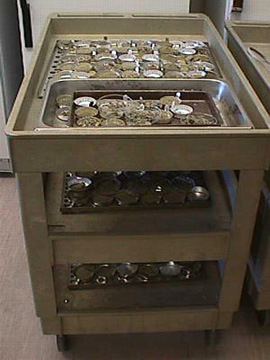
|
|
8 November, 1998
Yes, I was able to sleep in this morning until about 10:00 am! Lazy,
lazy, lazy...I ate breakfast and went over to the Crary Lab to start my
sediment sampling drying and weighing. We decided that I could work on
journaling a little bit first, so I spent until 2:30 pm trying to catch
up on journals...I only got two done. It takes a while to look at my
digital photos and decide which pictures I'm going to send to you.
I returned to the lab and began the process of organizing the sediment
samples. I arranged three sieves on top of one another (a 2 cm, 300
micrometer, and 63 micrometer), put a base on it to collect material
that would pass through the last sieve, and placed a top on the whole
thing (to prevent material from escaping out the top while shaking).
For each of the 60-some samples that I took from Lake Bonney, I put each
through the sieves and collected the subsamples at each stage (the 2 cm
stage, the 300 micrometer stage, and the 63 micrometer stage, and the
bottom stage) and placed them into small aluminum boats for drying. So,
roughly, I had 4 subsamples for each sample, giving me a total of about
240 samples! This took me the rest of the day until 10:30 pm. I placed
all of the samples into an oven and let them dry overnight. Tomorrow I
have to weigh them all!
As I mentioned in a previous journal, after drying and weighing the
samples, the vials will be sent to a lab for C/H/N (Carbon, Hydrogen,
Nitrogen) analysis. The compositions of these sediments can be compared
to the sediments that gather in the lake ice. The sediments in lake ice
find their way gradually down the ice column and collect in liquid water
pockets in the ice. It is around these sediment parcticles that
microbial life (algae and cyanobacteria) likes to grow. Where exactly
is the sediment coming from? What is the composition of the sediment?
There are lots of questions we want to know about the sediment since it
"houses" the microbial life in the lake.
Well, after a long day in the lab and no outdoor exercise, I don't know
if I'll sleep very well. I'll be dreaming soil, sediments, and
sieving...

The LOADS of sediment samples that I sieved, sorted, and prepared to be dried overnight in an oven. I just had to show you that I am actually working in Antarctica...just in case you are wondering...
Contact the TEA in the field at
.
If you cannot connect through your browser, copy the
TEA's e-mail address in the "To:" line of
your favorite e-mail package.
|
